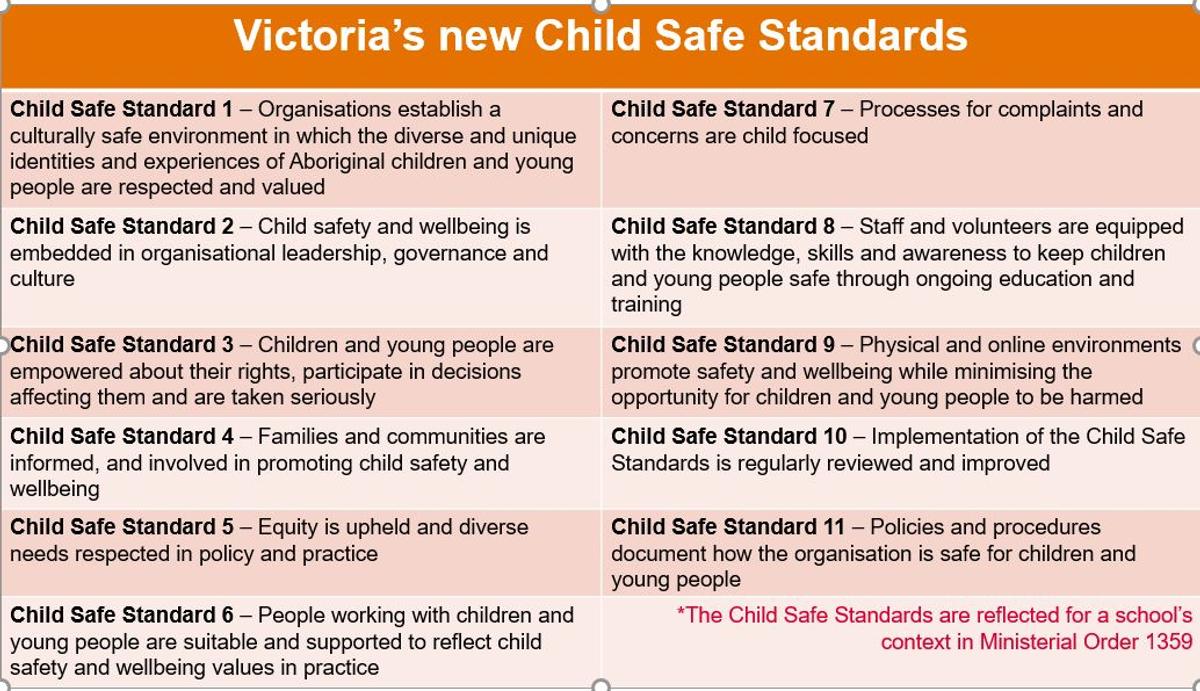CHILD SAFETY IS EVERYONE'S RESPONSIBILITY

CHILD SAFE STANDARD 6
People working with children and young people are suitable and supported to reflect child safety and wellbeing values in practice.
In complying with Child Safe Standard 6
The school council, parents and carers, visitors, staff and principal will:
Robust recruitment and screening
- Consider including students in the recruitment process to provide an authentic opportunity for them to have a say about decisions that impact them.
Advertising
- Ensure recruitment advertisements for staff in child connected work contain:
- the job’s requirements, including expected knowledge of child development appropriate to the role
- an outline of duties and responsibilities regarding child safety and wellbeing
- essential or relevant qualifications, experience and attributes in relation to child safety and wellbeing.
- Provide all job applicants with the school’s Child Safety and Wellbeing Policy and Child Safety Code of Conduct and links to child safety resources.
Screening
- Include selection criteria relevant to the role, such as:
- experience working with children, or particular groups of children, including children with a disability or Aboriginal children
- engaging with families
- child safety experience
- cultural safety in their work.
- Screen all staff, volunteers, leaders and school governing board members for their suitability during recruitment.
Interviews
- Think carefully about who will be on the interview panel and ensure panel members have the right skills, experience and information to perform their role.
- Develop questions about child safety for job interviews.
- Seek referees for both staff and volunteers as appropriate, including their last employer, and overseas referees if they’ve worked overseas.
- Ask referees about the person’s character and experience in working directly with children and young people.
Supervision and people management focused on child safety and wellbeing
- Conduct a risk assessment (refer to Standard 9) to determine what level of ongoing supervision and management is necessary, considering the physical layout of your school, any concerns that may have been raised previously and other relevant risk factors
- School leaders regularly walk-around classrooms and the school yard.
- Set out standards for child safety performance in staff contracts and state how performance will be assessed. Include child safety and wellbeing goals in staff professional development plans.
- Include child safety and wellbeing as a regular agenda item for staff meetings at all levels.These items could focus on elements of the school’s child safety framework, such as:
- identifying grooming and other behaviour that could cause harm to a student. Government schools can use the staff conduct case study (login required) to help staff identify potential grooming behaviours
- understanding what types of behaviour should be reported to school leaders
- how to respond to an incident, disclosure or suspicions of child abuse
- identifying risks in the school’s physical and online environment and who to report them to.
- Communicate regularly with staff and volunteers about the child safety and wellbeing, including promoting the school’s Child Safety and Wellbeing Policy and Code of Conduct in newsletters and staff updates.
- Conduct formal and informal observations of staff working with children. Provide feedback to staff on how to support student’s safety and wellbeing through regular check-ins or as appropriate.
- Assign a child safety champion or allocate a staff member responsibility to support the school’s implementation of a particular Standard (such as Child Safe Standard 1)
- Ensure all school leaders know how to manage a staff member whose behaviour raises child safety concerns. This includes:
- when to escalate concerns
- what records of conversations to keep
- how to follow up and monitor staff behaviour after immediate concerns have been addressed.
- Take early action to provide feedback to staff and correct any concerning or unsafe conduct to prevent harm before it occurs.
- Ensure systems are in place for recording information on staff conduct and any concerns raised.
Training and support to uphold child safety
- Refer to Standard 8 for further guidance on building child safety knowledge, skills and awareness.
- Nominate a child safety champion and support them to facilitate the induction and training programs for staff and volunteers.
- Provide induction that covers:
- the Child Safety and Wellbeing Policy
- the Child Safety Code of Conduct
- how to contribute to identifying, removing or reducing risks
- recordkeeping and information sharing requirements
- school values and philosophy
- procedures for managing complaints
- privacy and reporting protocols.
- Allocate a mentor to new staff for the first 12 months to provide guidance on teaching practices and professional conduct
- Train all staff and volunteers as appropriate to their roles, on topics such as:
- child safety (including family violence)
- mandatory reporting
- responding to student sexual offending
- human rights and the rights of children
- diversity and inclusion
- harassment and bullying
- cultural safety
- privacy and information sharing.
- Cover important topics in your child safety training, including:
- risk factors and signs of harm, including intentional and unintentional harm, physical or emotional harm, bullying or cyberbullying, abuse and neglect
- how to identify and respond to child safety risks, especially for vulnerable students
- how to facilitate child-friendly ways for students to express their views, participate in decision making and raise concerns
- how to engage with families to support student’s safety and wellbeing
- how to appropriately handle or share sensitive information relating to a child’s wellbeing health or safety.
- Deliver regular child safety briefings for all staff, for example through staff meetings, newsletters, year level briefings.
- For larger schools, consider implementing sub-school teams, with team leaders or child safety champions to observe school staff and discuss child safety.
- Inform staff and volunteers, as appropriate, of their responsibilities under the information sharing and family violence reforms.
Make child safety a key part of recruitment processes
- Provide role descriptions for staff and volunteers to clearly outline their duties and responsibilities regarding supervision, child safety and wellbeing, and diversity and inclusion. This may involve revising existing role descriptions.
- Make sure all staff, particularly those with mandatory reporting responsibilities, are aware of the up-to-date processes for making a report.
- Provide child safety champion/s with information to support their function relating to child safety, family violence and information sharing.
- Put a process in place to check staff and volunteers’ working with children clearance status or equivalent background check on at least an annual basis.
- Include child safety in ongoing staff support, supervision and performance management processes.
- Align complaints processes with best practice, including the PROTECT Four Critical Actions and Reportable Conduct requirements.
- Declare and manage any potential conflicts of interest, such as family or business relationships or close friendships.
- Provide clear avenues for staff to report concerns.
- Involve staff in after-action reviews when a child safety incident has occurred.

